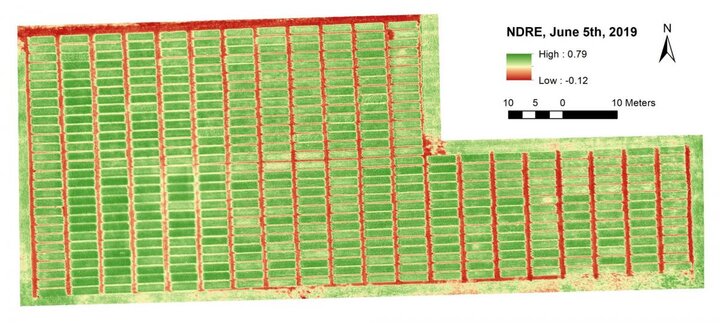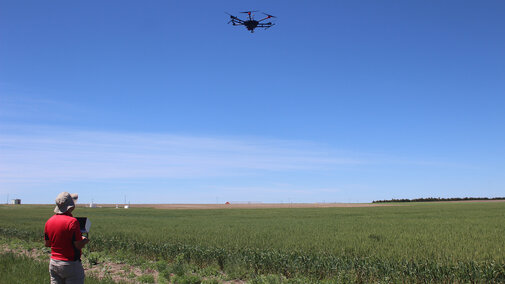The Protein Situation
For Nebraska dryland winter wheat producers, 2019 has been another challenging year. In many cases, grain harvested this summer had protein levels below 10%, the exception being where producers applied sufficient nitrogen (N) to achieve both high yields and protein.
Reports of low protein levels came from producers and co-ops. The University of Nebraska-Lincoln wheat variety trials recorded protein levels around 12% in most instances, with a few lines dropping below 10% in the Scotts Bluff County trial.
Wheat producers lose income as a discount kicks in at protein levels below 10%-11%, depending on the elevator. Despite high yields in the 2016 Nebraska wheat crop, low protein levels caused an estimated $2.3 million to $9.6 million loss in income. Similar low protein issues persisted in 2017.
Given these losses, a two-year study was initiated in the fall of 2018 to evaluate how soil N levels affect protein in Nebraska wheat. It is being conducted with support from the UNL Agricultural Research Division (ARD) and the Nebraska Wheat Board. The study also is intended to revise UNL fertility recommendations for wheat.
The UNL research team hopes to evaluate how grain quality, yield, and field stands are affected by N fertilizer rates and application timing. The trials are being conducted at research sites across the state with various precipitation amounts and soil types. The study also is testing the effectiveness of crop sensors in monitoring crop conditions and whether inputs are needed during the growing season.
Available soil N is the key factor determining the protein level in wheat. With low grain market prices, producers are under pressure to lower input costs, primarily for N fertilizer. However, reducing or eliminating N applications to winter wheat will typically result in low protein when yields are high and/or residual soil N is low.
The interaction between N and available soil moisture is important for profitable winter wheat production. High levels of soil moisture and favorable growing conditions increase tillering and wheat yield. As wheat yield increases, more N is required to maintain adequate protein levels.
In order to increase protein levels in wheat, N must be properly managed in the soil and be available for plant uptake during grain development.
Establishing a Data Foundation for New Winter Wheat N Recommendations
Accurately predicting how much N wheat will need requires an extensive data set. The last predictive N algorithm for dryland winter wheat production in Nebraska was prepared in the 1970s. Considering the progress made in traits and management, and changing climatic conditions, there is a need for re-assessing the N recommendation in dryland wheat.
Working toward that goal, in 2018 a dryland winter wheat fertility trial was initiated at four locations:
- the High Plains Ag Lab near Sidney,
- the Henry J. Stumpf International Wheat Center near Grant,
- the Eastern Nebraska Research and Extension Center at Mead, and
- the Panhandle Research and Extension Center at Scottsbluff.
The goal of this study is to understand effects of N application rate and timing on grain yield and quality.
First Year Outcomes and Weather Woes
In 2019 the data from the four sites was affected by weather, disease, and other factors. Unfortunately, the trial at Scottsbluff was lost to hail damage. At Mead, increased N rates surprisingly did not result in increased grain yield. This might be due to Fusarium Head Blight (FHB) at the site, among other factors. The severity of fusarium head blight is known to be higher in wheat fertilized with higher N rates and in wetter conditions such as those common at Mead.
At Grant and Sidney, data suggest that grain yield may be improved by optimizing N rates and application timing. At Grant, precipitation was above-average from May through July, when the crop goes through tillering, booting, heading and flowering, increasing daily crop water use. This resulted in considerably high yield across all N treatments. Spring N application and split application (one-third of N rate in the fall and two-thirds in the spring) gave greater grain yields compared to fall application. There was a linear increase in grain yield with increasing N rates. The same was true at Sidney; however, grain yield did not differ by application timing there.
At Grant and Sidney, the data from grain analysis for protein shows that protein content may be altered by N rates but not by application timing. The protein levels ranged from around 10% at no or low N rates to 11.5% at 75 lbs N acre. The finding is not conclusive as this is the first year of the study that will continue at multiple sites for one or more years, depending on funding availability.
Utilizing New Technology
Data from this study also suggest that crop sensors can be effective in letting producers know whether additional inputs are needed during the growing season, particularly in-season applications directed toward improving grain quality.
Data on vegetative indices obtained from hand-held and UAV-mounted (drone) sensors are being analyzed as well. The initial analysis shows significant differences in Normalized Difference Red Edge (NDRE) values among different N rates. Based on these results, the team will develop and share with producers crop sensor-assisted, in-season N application algorithms to increase grain yield and quality.

Making Good Bread
Grain samples from all four locations from this year’s study will be analyzed at the university's Food Processing Center Lab for other selected end-use quality parameters on straight grade flour and whole-wheat flour, including:
- particle size distribution (whole wheat flour only),
- asparagine, and
- baking quality (mixograph).
A Look Back at the End of Season
At all locations, post-harvest soil samples will be analyzed for residual mineral N, which will shed some light on yields observed in this experiment. It is likely that in years when there is abundant precipitation during the fall and subsequent spring, soil N moves deeper into the soil profile, out of the root zone. That would suggest a benefit to splitting N applications.
Keep Up With Us
Keep visiting CropWatch as we will continue to share more analysis and findings from this study. If you’re interested in reading more articles on winter wheat production from our researchers, graduate students, extension specialists and educators, visit cropwatch.unl.edu/wheat.

